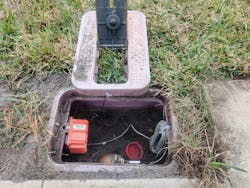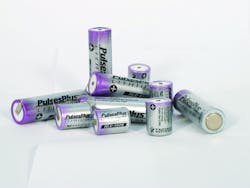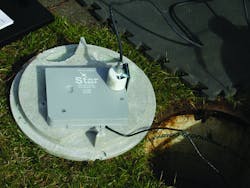Leaking pipes cause 6 billion gallons of America’s treated drinking water to be lost each day, according to the American Society of Civil Engineers. Enhanced data intelligence is essential to preventing this loss.
Battery-powered remote monitoring devices are being utilized worldwide to protect and preserve precious water resources. These battery-powered solutions increasingly utilize two-way wireless communications to deliver enhanced data intelligence. This intelligence can support applications ranging from advanced meter reading (AMR)/advanced metering infrastructure (AMI) to water and wastewater storage and distribution.
One solution, battery-powered remote wireless technology, conserves water by pinpointing leaks and detecting theft of services. This advanced technology also serves to reduce long-term maintenance costs, improve billing and payment systems, and promote employee safety with remote on/off capabilities.
Achieving Cost Savings with AMR/AMI
A major point of savings with AMR/AMI can be found in the meters’ service life.
Battery-powered ultrasonic meter reading devices contain no moving parts so they can last indefinitely, limited only by the life of the battery. Ultrasonic meters also cost roughly twice as much as the mechanical meters they replace, so their tangible benefits must outweigh the added expense.
This subject was explored by Hans Allender in a study of residential water meters in Arundel County, Md. While analyzing non-commercial water usage in the area, Allender found that mechanical water meters became increasingly inaccurate over time — to a point where, after 16 years, the accumulating losses started to exceed the initial cost savings achieved with less expensive mechanical meters.
Choosing a Battery
While the cost of batteries is fractional compared to the total investment required to implement an AMR/AMI solution, they are often seen as the most critical component. A survey conducted by the California Energy Commission (CEC-2010-08) found that 62 percent of respondents from the Association of California Water Agencies (AWCA) considered meter battery life as “very important” to an AMI deployment, eclipsing overall cost concerns (60 percent).
Common sense dictates that pairing a more than 20-year-long service life meter transmitter unit (MTU) with a 10-year battery is not economical. Further, choosing a short-lived battery could heighten the risk of having to preemptively replace thousands of batteries each year to avoid the chaos of a large-scale battery failure that disrupts billing systems, reduces cash flow, and slashes ROI.
To achieve extended battery life, leading MTUs utilize bobbin-type lithium thionyl chloride (LiSOCl2) cells that feature an exceptionally low annual self-discharge rate of less than 1 percent per year. Bobbin-type LiSOCl2 batteries are overwhelmingly preferred for remote wireless applications due to their unrivaled capacity and energy density, wide temperature range (from -80° C to 125° C), and very low self-discharge rate.
All batteries experience some amount self-discharge even when the battery is disconnected. Bobbin-type LiSOCl2 batteries lowers its self-discharge by harnessing the passivation effect: a phenomenon that occurs when a thin film of lithium chloride (LiCl) forms on the surface of the lithium anode to impede the chemical reactions that lead to higher self-discharge.
When a load is placed on the cell, the passivation layer causes initial high resistance, resulting in a temporary drop in cell voltage until the discharge reaction slowly removes the passivation layer: a process that keeps repeating each time the load is removed. Higher levels of passivation can reduce battery self-discharge, but too much of this effect can be problematic if it overly restricts energy flow.
Battery self-discharge can also be affected by the quality of the raw materials and the method by which the battery is manufactured. For example, an inferior quality bobbin-type LiSOCl2 battery can lose up to 3 percent of its nominal capacity each year due to self-discharge, exhausting 30 percent of its total capacity every 10 years, making a 20-year battery life unachievable.
By contrast, a superior quality bobbin-type LiSOCl2 battery can feature a self-discharge rate of just 0.7 percent per year, able to retain 93 percent of its original capacity after 10 years, making 40-year battery life possible for certain low-power devices.
The ultra-long-life potential of a bobbin-type LiSOCl2 battery was verified by Aclara (formerly Hexagram), a smart infrastructure company, while replacing older generation AMR meters first installed in the mid-1980s. Random tests found that these older batteries had retained a significant amount of unused energy capacity even after more than 28 years in the field.
Smart Solutions Demand High Pulse Energy
Standard bobbin-type LiSOCl2 batteries are not designed to deliver the high pulses required to power remote two-way wireless communications: a challenge that can be easily overcome with the addition of a patented hybrid layer capacitor (HLC). The standard bobbin-type LiSOCl2 cell delivers low background current while the HLC delivers periodic high pulses.
The HLC also features an end-of-life voltage plateau that can be interpreted to deliver low battery status alerts that simplify battery replacement. Similar technology is used to monitor all types of hard assets found in modern water infrastructure. The following are two real-life examples.
Capturing Reclaimed Water
With fresh water being such a precious commodity, the municipal water system of Orange County, Fla., relies on reclaimed wastewater to irrigate golf courses, resorts, and residential gardens. Residential customers who also depend on these storage tanks for home gardening often lacked a sufficient supply of water at times when golf resorts were watering the greens.
Orange County’s Public Works Department installed Ayyeka Wavelet™ devices to continually monitor water usage at golf courses and resorts to provide enough water for residential gardens. AI-enhanced real-time monitoring of reclaimed water collection and usage patterns helped build predictive models to estimate future demand. This enabled the department to proactively plan for long-term expansion.
Monitoring Pressure Reducing Valves
With over 600 miles of water mains, Erie County, Pa., utilizes pressure reducing valves (PRVs) to reduce stress on a 100-year-old system prone to leaks and bursting pipes that could potentially affect over one million customers. Previously, service crews lacked the data intelligence to anticipate potential ruptures to the main water line.
Ayyeka delivered a comprehensive end-to-end solution using lithium battery-powered Wavelet™ devices to continuously monitor the PRVs, providing municipal managers with automatic text messages, emails, and cell phone alerts if pressure levels begin to drop. In addition, Field Asset Intelligence™ (FAI) software was utilized to detect small leaks before they lead to costly and disruptive water main ruptures.
Long-Life Performance Cannot be Easily Simulated
Comparing batteries based on their self-discharge rate can be extremely difficult. Long-term performance characteristics cannot be reliably simulated using short-term test data that typically underestimates the passivation effect as well as long-term exposure to extreme temperatures.
If extended battery life is essential, utility managers need go the extra mile and perform thorough due diligence to verify all claims being made by battery manufacturers. This evaluation process begins by demanding fully documented long-term test results, in-field performance results under similar loads and environmental conditions, and multiple customer references. WW
About the Author: Sol Jacobs is vice president and general manager for Tadiran Batteries. He has over 30 years of experience in powering remote devices.
Published in WaterWorld magazine, June 2022.






